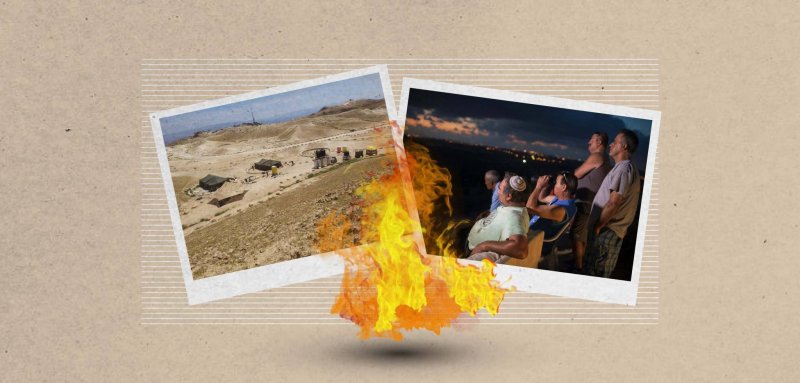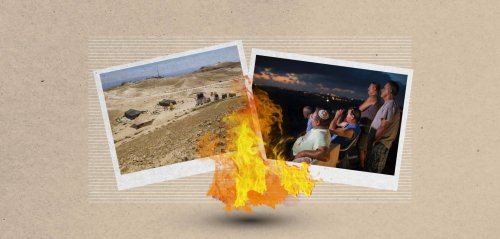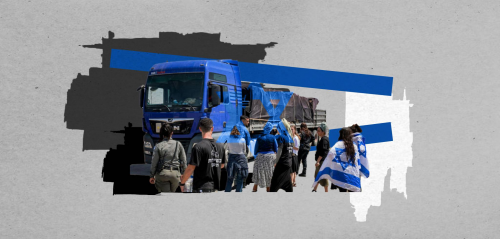Over a decade ago, Israeli settlers came up with the idea of establishing the ‘Sderot cinema.’ At sunset, they gather on hillsides, seated on plastic chairs and old couches, snacking on popcorn and sunflower seeds and smoking hookahs, to watch and cheer as bombs and fire rained down on the homes of Gazans. They call it a “fun night of entertainment.”
This disturbing phenomenon, which would be later described as "genocide tourism," doesn’t end there. A video clip from the documentary ‘Holy Redemption: Stealing Palestinian Land’ recently circulated on social media. It shows Israeli settlers organizing boat tours to watch the rockets fired from Israel towards Gaza, demolishing buildings and inflicting hundreds of civilian casualties.
Genocide tourism is deeply intertwined with the religious and settler-colonial elements of Zionist ideology and has become particularly prominent during this war.
“Israeli tourists intentionally watching the horrors of war and genocide and turning it into a spectacle of sorts reveals a deep sense of savagery and a perverse pleasure derived from others' suffering," explained Abaher el-Sakka, a researcher and sociologist, to Raseef22.
Genocide tourism is deeply intertwined with the religious and settler-colonial elements of Zionist ideology. It has become particularly prominent during this war, personified by many Israeli figures such as National Security Minister Itamar Ben-Gvir, Finance Minister Bezalel Smotrich, and Daniella Weiss, the founder of the settler organization Nachala. Weiss herself led one of the boat tours to witness the destruction being unleashed upon Gaza.
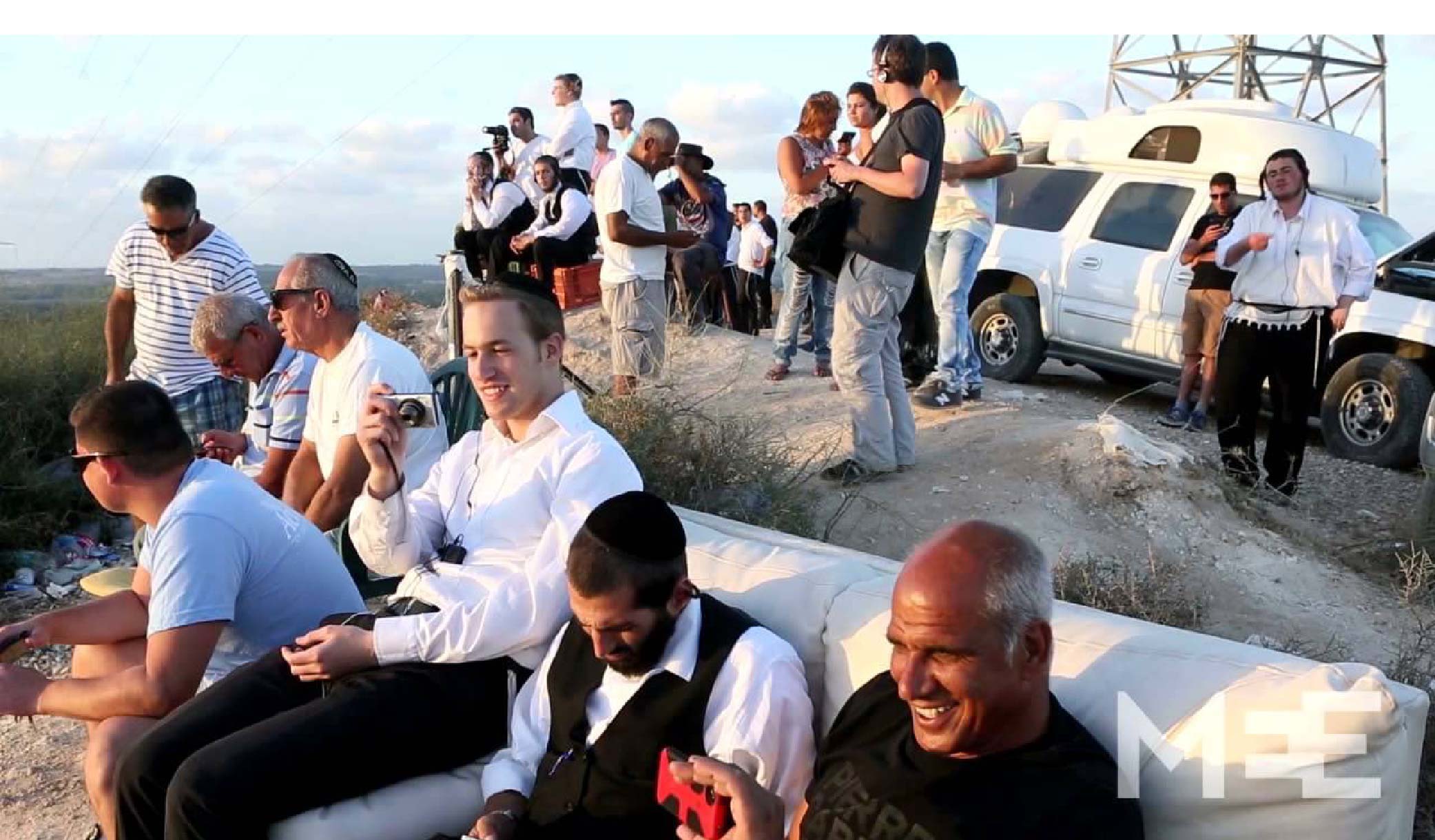 The ‘Sderot cinema’: Israelis gather on a hillside to watch the bombing of Gaza
The ‘Sderot cinema’: Israelis gather on a hillside to watch the bombing of Gaza
The ‘Sderot cinema’: Israelis gather on a hillside to watch the bombing of Gaza
Watching genocide up close
Typically, tourists visit conflict zones or war sites to see remnants of tanks or warplanes, aiming to reflect on the atrocities and genocides experienced by nations. This phenomenon, known as ‘genocide tourism,’ gained popularity in the 1990s when about half a million tourists visited the Auschwitz concentration camp in Poland annually, the site where the Nazis committed some of the most heinous acts of genocide.
“Israeli tourists intentionally watching the horrors of war and genocide and turning it into a spectacle of sorts reveals a deep sense of savagery and a perverse pleasure derived from others' suffering." — Researcher and sociologist Abaher el-Sakka to Raseef22
Genocide tourism is closely related to ‘dark tourism,’ or ‘black tourism,’ which involves traveling to past or ongoing war zones.
The term "dark tourism" first emerged in 1996 in the book Dark Tourism: The Attraction of Death and Disaster by Scottish academics John Lennon and Malcolm Foley.
The book examines the "ethical dimensions of people visiting detention and torture camps in Western and Eastern Europe, for example, after they have been transformed into heritage sites, such as the Tower of London and Edinburgh Castle in Britain, or the Berlin Wall in Germany."
With the advancement of marketing tools, genocide tourism has taken on a different trajectory. Philip Stone, director of the Institute for Dark Tourism Research at the University of Central Lancashire, explains that what is new in dark tourism today lies in its commercialization.
“What’s changing is how these trips are being formalized through the tourism industry, as well as the fact that technology and the Internet are also picking up on it” to attract tourists from around the world.
Israel's genocidal tourism
To give the matter a political dimension, Israeli politicians and settlers have devised new forms of tourism that go beyond viewing remnants of wars—they allow spectators to witness their horrors firsthand.
“The scenes of genocide that Palestinians are subjected to become a source and material for pleasure and enjoyment. The victim's body is violated and ogled, in the most horrific and normalized ways, devoid of any feelings or emotions.”
The geographic location of Israel has made it a magnet for genocidal tourism. Israel has welcomed thousands of visitors to its border areas to witness its bloody wars in Palestine and Syria at various points in time.
In Palestine, the area of Sderot, a settlement built on the ruins of the depopulated and forcibly displaced village of Najd, has seen dozens of tourists visit to watch large-scale military operations in the border areas with Gaza after 2005. Tourists sit on chairs, applaud as they watch rockets launched by aircraft targeting civilians, and cheer when the Iron Dome intercepts resistance rockets, according to a story published by The Atlantic.
As for Syria, the report notes that the Golan Heights became an area of attraction for tourists to witness the killing and destruction that afflicted Syria after the revolution. Israeli tourists would flock “by the dozens each day armed with binoculars and cameras, eager for a glimpse of smoke and even carnage.” They’d watch the fiercest battles, rising smoke columns, and ongoing massacres from a vantage point known as the southern gateway to Damascus in the Heights.
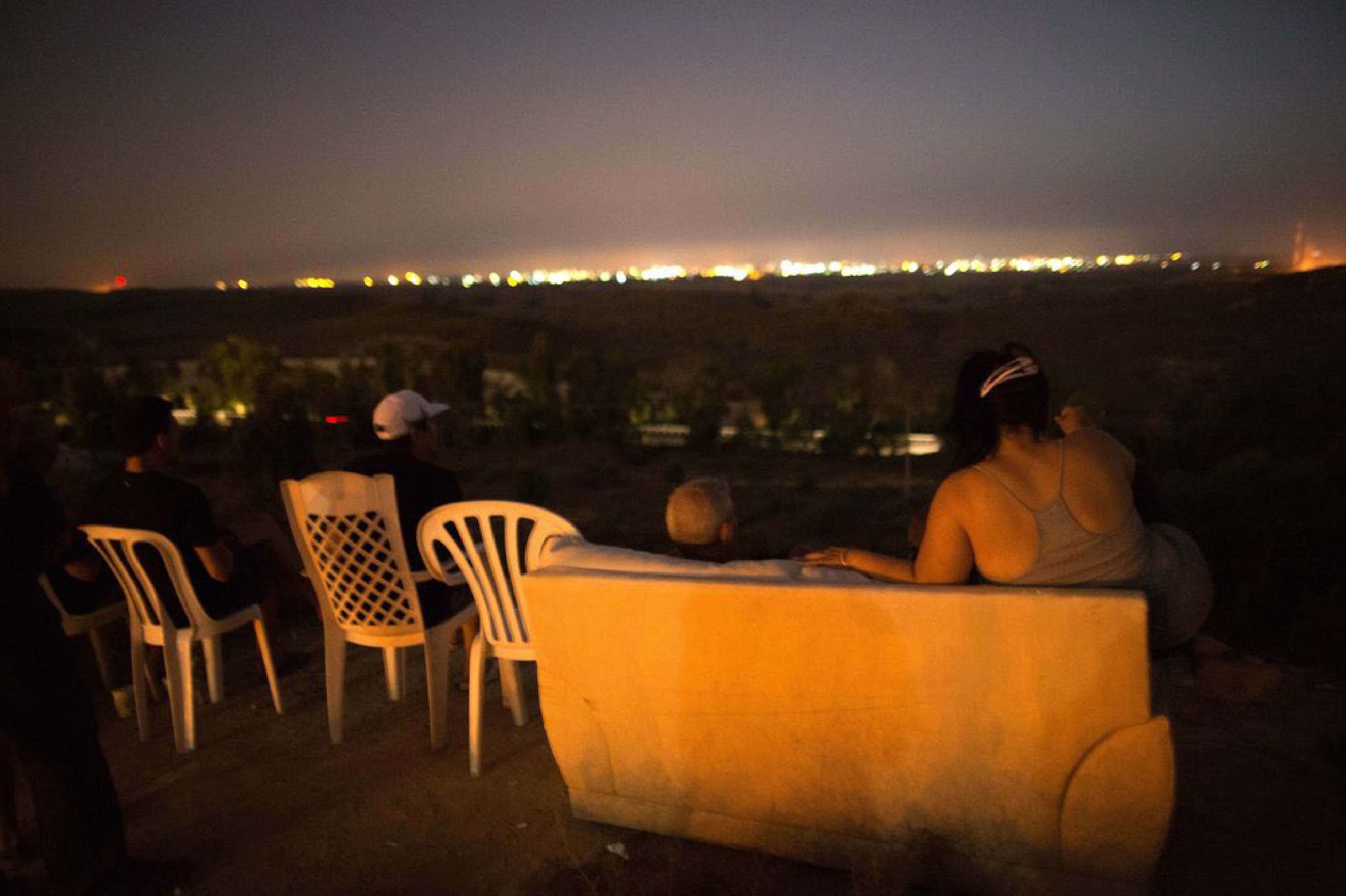 The ‘Sderot cinema’: Israelis sit and watch the bombing of Gaza
The ‘Sderot cinema’: Israelis sit and watch the bombing of Gaza
The ‘Sderot cinema’: Israelis sit and watch the bombing of Gaza
The view from the cheap seats after October 7
Genocide tourism intensified on Gaza's borders following Israel’s genocidal war that began on October 7, 2023. Approximately 200,000 visitors came to the Gaza envelope region during the first half of 2024, compared to 100,000 visitors in previous years, according to Israeli estimates. These visitors include “solidarity missions” and delegations from abroad, local visitors, such as Israeli settlers, soldiers, and police officers participating in “educational tours.”
In these tours, "tourists" visit the aftermath of October 7 in the ‘kibbutzim’ around Gaza, viewing destroyed homes and a child’s bed placed on the street, riddled with bullets. These tours have turned the area into an open-air museum and promote the kibbutz narrative to both local and international visitors, including figures like Elon Musk, who accepted Israel’s invitation to observe the destruction. Birthright Israel, an organization that offers subsidized 10-day trips to Israel for Jewish Americans, has predicted that around 13,500 participants will visit Sderot and the site of the Nova Music Festival. The organization emphasized that “these visits provide an economic and morale boost to residents.”
Genocide tourism intensified on Gaza's borders following Israel’s genocidal war that began on October 7, 2023. Approximately 200,000 visitors came to the Gaza envelope region during the first half of 2024. These visitors include “solidarity missions” from abroad, Israeli settlers, soldiers, and police officers participating in “educational tours.”
Israeli tourism companies, for their part, significantly increased their advertisements for tours in these areas after October 7. The company Bein Harim Israel Tours, a tourism services company licensed by the Israeli government, announced a private tour of the Gaza strip. The cost of the trip starts at $800 and includes visits to the border areas between Israel and Gaza to view the separation fence, a stop at the Erez Crossing to witness the daily humiliation Palestinian workers endure as they head to work in the occupied territories, and other locations connected to the events of October 7.
On another tourist website called Green Olive Tours, an excursion titled “Gaza Border Tour” takes visitors to the Gaza envelope to witness the siege imposed on the area, explore the history of settlement evacuations and tunnels leading to Egypt, and visit significant sites to see rocket attacks and experience what life is like for Israelis living near those borders.
“Despite its illegality, Israeli authorities continue to grant licenses to companies that promote genocide-viewing tours as a way to promote and reinforce settlement on the occupied Palestinian territories… The goal of genocidal tourism is to mislead, distort, and steal by spreading the occupation’s narrative and strengthening its historical and political claims to control the land.”
Spectating death and slaughter: Treating illness with illness
Analysts suggest that genocide tourism is connected to Israelis' relationship with borders and security.
“After October 7, Israel has become more aggressive in defending its borders, perceiving them as lines of safety that must be continuously monitored,” says genocide scholar and researcher Dirk Moses. “As such, genocide tourism is not just about solidarity with those who have lost loved ones in the war, but solidarity with the borders—solidarity with those who have, at least psychologically, lost their sense of security.”
However, el-Sakka disagrees that genocide tourism is linked to Israel’s obsession with borders and security, arguing instead that “Israel is a state without borders, and is still seeking further colonial expansion and settlement.”
“Many Israelis see these tours as a way to promote the historical narrative of the occupation to the world and to attempt to reshape international perspectives and change views regarding the nature of the war. But in reality, it does the opposite—it further exposes the brutality of Israelis and their violations of human rights.”
“Genocide tourism is tied to the fusion of the occupation’s savagery with its consuming audience—the tourists—who endorse the act, and with the Israeli military that carries it out,” he tells Raseef22. “In this space, the mentality of vengeance and brutality converges to target Palestinians who are seen as deserving death by all means.”
Genocide tourism also holds psychological significance for Israelis. One tourist described it as “treating illness with illness.” In the film War Matador, Abramson, an Israeli filmmaker from Jerusalem, documented scenes of tourists, most of them settlers, at the Gaza border watching as rockets were being launched into the Strip. “It’s surreal,” reflects one American immigrant interviewed in the film, “that suffering and life happen in this way and at the same time.”
“The scenes of genocide that Palestinians are subjected to become a source and material for pleasure and enjoyment,” El-Sakka continues. “The victim's body is violated and ogled, in the most horrific and normalized ways, devoid of any feelings or emotions.”
“Genocide tourism is tied to the fusion of the occupation’s savagery with its consuming audience—the tourists—who endorse the act, and with the Israeli military that carries it out. In this space, the mentality of vengeance and brutality converges to target Palestinians who are seen as deserving death by all means.”
Genocide tourism takes on a symbolic dimension as part of the process of survival. Irit Lahav, spokesperson for the Nir Oz settlement, who organizes many tours to the Gaza border, said in an interview with the Associated Press that “it’s [their] personal story, but it’s also the story of all of the state of Israel.” She added that it is important for “people to come here and smell the burning smell of death, to imagine your friends or parents here.”
Tourism to promote the Israeli occupation’s narrative
Genocide tourism is not considered a legal practice, according to Azzam Salameh, a specialist in tourism affairs in Palestine.
“International law does not recognize the legality of settlements, as they constitute a violation of Article 49 of the Geneva Convention and are contrary to international declarations,” he tells Raseef22. “Therefore, any Israeli activity conducted on these lands is equally illegal.
“The goal of genocidal tourism is to mislead, distort, and steal by spreading the occupation’s narrative and strengthening its historical and political claims to control the land. These visits are also connected to the search for religious and historical roots, which Israelis use as part of their nationalist and religious discourse to justify settlement and Judaization.
“Many Israelis see these tours as a way to promote the historical narrative of the occupation to the world and to attempt to reshape international perspectives and change views regarding the nature of the war. But in reality, it does the opposite—it further exposes the brutality of Israelis and their violations of human rights.
“Despite its illegality, Israeli authorities continue to grant licenses to companies that promote genocide-viewing tours as a way to promote and reinforce settlement on the occupied Palestinian territories.”
While thousands of Israeli tourists once traveled to Nazi camps to witness the remnants of the genocide committed against them, they now traverse mountain edges and sea expanses to witness the horrific crimes of genocide they themselves commit against Palestinian civilians in Gaza—a shift from the role of victim to the role of executioner.
While thousands of Israeli tourists once traveled to Nazi camps to witness the remnants of the genocide committed against them, they now traverse mountain edges and sea expanses to witness the horrific crimes of genocide they themselves commit against Palestinian civilians in Gaza—a shift from the role of victim to the role of executioner. This transition was succinctly reaffirmed by a member of the municipal council of the northern Israeli city of Metula, who stated that the “Gaza Strip must be completely emptied and razed to the ground, just as happened in Auschwitz.”
Raseef22 is a not for profit entity. Our focus is on quality journalism. Every contribution to the NasRaseef membership goes directly towards journalism production. We stand independent, not accepting corporate sponsorships, sponsored content or political funding.
Support our mission to keep Raseef22 available to all readers by clicking here!
Interested in writing with us? Check our pitch process here!
